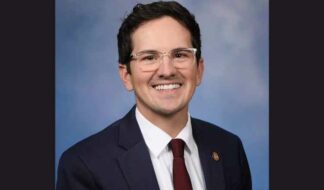by Bob Roehr
MEXICO CITY –
The International AIDS Conference is almost a misnomer. It is not one conference, but a dozen of them running simultaneously under the same huge umbrella. Participants pass each other in the hallways and by the exhibitors' booths, but the sessions they attend can vary dramatically from basic research, to human rights, to the nitty-gritty of prevention outreach to sex workers.
So it is inevitable that reports from the XVII conference in Mexico City have a bit of the quality about them of a group of blind men describing an elephant – each piece is true, but none can encapsulate the beast entirely.
Separate satellite conferences preceded the main event, including one on men who have sex with men and HIV. On Aug. 2, local and international participants by the thousands joined together for Mexico's first ever "March against Stigma, Discrimination and Homophobia."
It swirled around the Angel of Independence and up the monumental Paseo de la Reforma to the Zocolo, the central points of celebration and protest in Mexico. At times it seemed to be less of a march than a giant party where marchers and watchers blurred into one as they floated along the grand avenue.
Contingents of out and proud gays, sex workers, people living with HIV, PFLAG parents, drag queens and muscle boys all made the case for greater tolerance and acceptance in a society where machismo is still a powerful force. But times are changing and, earlier in the week, the President of Mexico met with a gay group for the first time.
Prevention
"Prevention is slowly getting back on the agenda. We hope that this week can accelerate the process," said Peter Piot, the head of UNAIDS.
"Isolated prevention interventions simply don't work," added Piot, who emphasized it has to be a combination of activities that offer people choices and that reinforce each other – there is no silver bullet.
Many leaders hope that Mexico City will become known as a turning point in prevention efforts in much the same way that the 2000 Conference in Durban, South Africa became the turning point in expanding access to treatment.
Julio Montaner made the link between treatment and prevention. He commented that if you get people on therapy and reduce viral load enough, transmission of new infections will go down. People have thought that for years, but it has taken time to prove it.
"We believe that now there is enough evidence to tell policy makers that," said Montaner. He chose an example from his own home of British Columbia. When they first rolled out antiretroviral therapy, "the number of new infections dropped by 53 percent."
"Paradoxically, it may have been that we needed all of this attention and rolling out of treatment programs before we could really seriously start with prevention," said Piot.
UCLA's Tom Coates pointed out the "unparalleled impediments to implementing HIV prevention strategies all over the world, be it related to sexual activity or substance use."
Inadequate funding and often a lack of accountability compound those problems. Coates said accountability must start at the street level where programs are implemented and extend through to the national political level where leaders should be judged on the success of their HIV prevention programs.
Treatment
The big talk on the treatment front was not about a new drug but an old one, abacavir, which was approved by the FDA nearly a decade ago. It is sold alone under the name Ziagen and as part of the combination drugs Epzicom and Trizivir.
In January a data safety monitor board noticed that patients with a viral load over 100,000 and taking abacavir as part of their first combination therapy were less likely to suppress their virus below the level of detection than were patients on the other regimen. They stopped that portion of the trial. But curiously, they apparently didn't see the same pattern in patients with a viral load less than 100,000 and that part of the trial was allowed to continue.
Paul Sax made the first presentation of that data from the ACTG 5202 study. He said its larger size "may have allowed us to describe differences between the groups with greater precision than with a smaller sample size." The use of different drugs in the rest of the regimen might also help to explain the differences, Sax said.
GlaxoSmithKline, which makes abacavir, presented its own analysis, noting that the Sax study used different criteria than most other studies. It reviewed six recent trials of the drug involving 2,940 treatment-naive patients using the ACTG 5202 endpoints. Company researcher Keith Pappa said, "The range of response is between 87 percent and 95 percent," and there was no significant difference by baseline viral load.
Bob Huff, with the AIDS "think tank" Treatment Action Group (TAG), thought it important to remember that the portion of the trial involving patients with a lower initial viral load was not stopped. He treated the report seriously, but given that, and all of the other data, thought it was possible that it might be a statistical fluke.
What did shock Huff was that a patient in the ACTG trial had died of a hypersensitivity reaction on restart of abacavir. He said, "If it is happening among that group of highly-sophisticated physicians, then it is happening elsewhere."
There was another piece of bad news for abacavir earlier this year when researchers noticed that patients in the D:A:D cohort study who were on the drug were more likely to suffer from cardiovascular disease than those who were not. The same team looked at data from the SMART cohort study and, in Mexico City, said they had found the exact same associations.
Study author Jens Lundgren said these findings are likely to be important only to a subset of patients, "namely those who have several underlying cardiovascular risk factors. For most patients, this is not an issue."
Kenneth Mayer, with Fenway Community Health in Boston, said this reinforces the need for doctors and patients to monitor for cardiovascular risk factors such as smoking, hypertension, and being overweight. "If you work on those you can minimize any potential risk from abacavir, if it really does exist."
He called abacavir "a good drug" and would hate to see an overreaction on the part of doctors who would be afraid to use it where appropriate.









